Transform your camping experience by mastering the art of campsite management in Ontario’s wilderness. From the moment you arrive at your designated spot in one of Ontario’s pristine provincial parks, every decision you make shapes not only your outdoor adventure but also your impact on the natural environment. Effective campsite management goes beyond simply pitching a tent – it’s about creating a temporary home that balances comfort with conservation, safety with sustainability.
Whether you’re a first-time camper or a seasoned outdoor enthusiast, proper site organization can mean the difference between a memorable wilderness experience and a challenging ordeal. Learn how to select the ideal tent location, establish efficient cooking areas, and implement wildlife-safe food storage systems while minimizing your environmental footprint. By following proven campsite management techniques, you’ll create a comfortable basecamp that serves as the perfect launching point for your Ontario Parks adventure, while preserving these natural spaces for future generations to enjoy.
Throughout this guide, we’ll explore essential strategies that combine traditional camping wisdom with modern conservation practices, ensuring your campsite becomes a model of outdoor stewardship.
Choosing the Perfect Campsite Location
Understanding Ontario Parks’ Site Classifications
Ontario Parks offers various campsite classifications to suit different camping styles and preferences. Before you reserve your ideal campsite, it’s essential to understand these options.
Electrical sites come equipped with 15/30-amp service, perfect for RVs and trailers or those needing power for medical devices. Non-electrical sites offer a more traditional camping experience and are typically more secluded, ideal for tent camping and disconnecting from modern conveniences.
Radio-free zones provide a peaceful escape where electronic devices and music players aren’t permitted, creating a tranquil environment for nature enthusiasts. For those seeking extra privacy, premium sites offer larger spaces and are often situated in prime locations with scenic views or waterfront access.
Group camping areas accommodate larger parties and are designed with multiple tent pads and communal spaces. Some parks also feature car-free sites, requiring a short walk from the parking area, which offers an authentic backcountry feel while maintaining easy access to facilities.
Pro tip: Consider shoulder season camping in electrical sites – they’re usually less crowded and you’ll have the option of heat if temperatures drop unexpectedly!
Site Features to Look For
Choosing the right spot for your campsite can make or break your outdoor experience. Look for a level area that’s slightly elevated to prevent water pooling during rain. Natural shade from trees is ideal, offering protection from both sun and light rain, but avoid setting up directly under dead branches that could fall.
Consider the distance to facilities – you’ll want to be close enough to washrooms for convenience but far enough to avoid traffic and odors. Pro tip: sites between 50-100 meters from amenities often offer the perfect balance.
Check the ground surface carefully. A mix of grass and packed earth provides excellent drainage and tent stability. Remove any rocks or sticks that could damage your tent floor or make sleeping uncomfortable. For extra comfort, position your tent entrance to catch morning sun and cooling afternoon breezes.
Pay attention to natural windbreaks like bushes or rock formations, which can protect your site from strong gusts. Finally, ensure you have enough space for all your gear while maintaining a comfortable distance from neighboring campsites – nobody likes feeling cramped in the great outdoors!
Setting Up Your Campsite Like a Pro
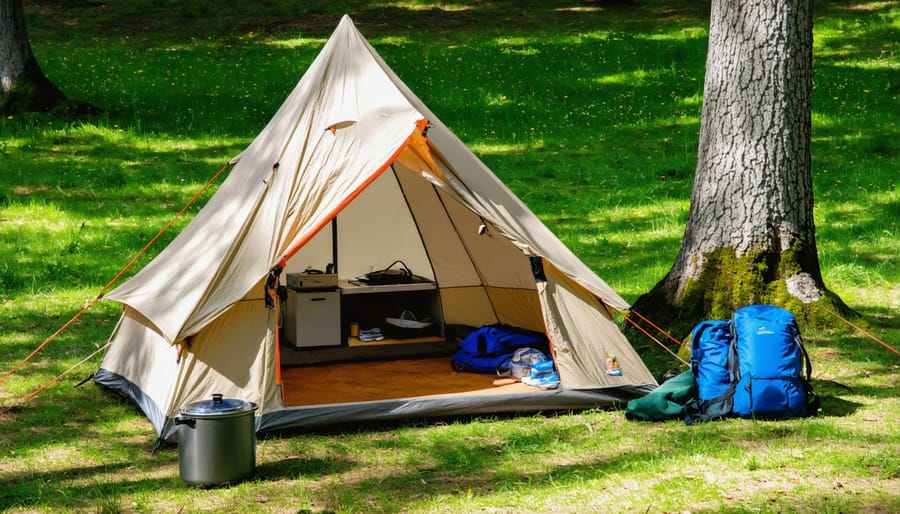
Essential Layout Tips
A well-organized campsite is your home away from home, and getting the layout right can make or break your outdoor experience. For helpful beginner camping tips, start by choosing a level spot for your tent, ideally on slightly elevated ground to prevent water pooling during rain. Place your tent with the door facing east to catch the morning sun and away from the prevailing wind direction.
Create distinct zones within your campsite to keep things tidy and functional. Set up your cooking area at least 10 meters from your tent for safety, and position it downwind to prevent food smells from attracting wildlife to your sleeping area. A designated prep surface, like a portable table or flat rock, makes meal preparation much more enjoyable.
Establish a gear organization system early on – I like to use a large tarp under my tent’s vestibule for muddy shoes and wet gear. Keep frequently used items like headlamps and water bottles in easily accessible spots near your tent entrance. Create a dedicated storage area for food and scented items in animal-proof containers, and always hang them or store them in your vehicle at night.
Pro tip: Map out your site’s layout before setting up, using natural features like trees and rocks to your advantage. This thoughtful approach will save you time and create a more comfortable camping experience.
Weather-Ready Setup Strategies
Ontario’s weather can be unpredictable, so setting up your campsite to handle whatever Mother Nature throws at you is essential. Start by choosing a spot that’s slightly elevated to prevent water pooling during rain. If possible, position your tent with the door facing east to catch the morning sun and avoid the strongest afternoon heat.
Create a multi-layered defense against wet weather by using a ground sheet under your tent and ensuring your rainfly extends well beyond the tent walls. Pro tip: bring extra tarps to create a sheltered cooking and gathering area. Set these up with a slight angle to direct water away from your site and maintain proper airflow.
For wind protection, use natural barriers like trees or large rocks, but remember to stay clear of dead branches that could fall during storms. Keep your gear organized in waterproof containers and store them under tarps or in your vehicle when not in use.
In summer, maximize shade by strategically hanging tarps or using pop-up canopies. For spring and fall camping, position your site to catch maximum sunlight and bring plenty of warm, moisture-wicking gear. Consider creating a small drainage trench around your tent if heavy rain is forecasted, but remember to fill it in before departing.
Leave extra guylines and stakes at home – they’re lifesavers when reinforcing your shelter during unexpected weather changes. A well-prepared campsite means you can stay comfortable and enjoy the outdoors, regardless of the forecast.
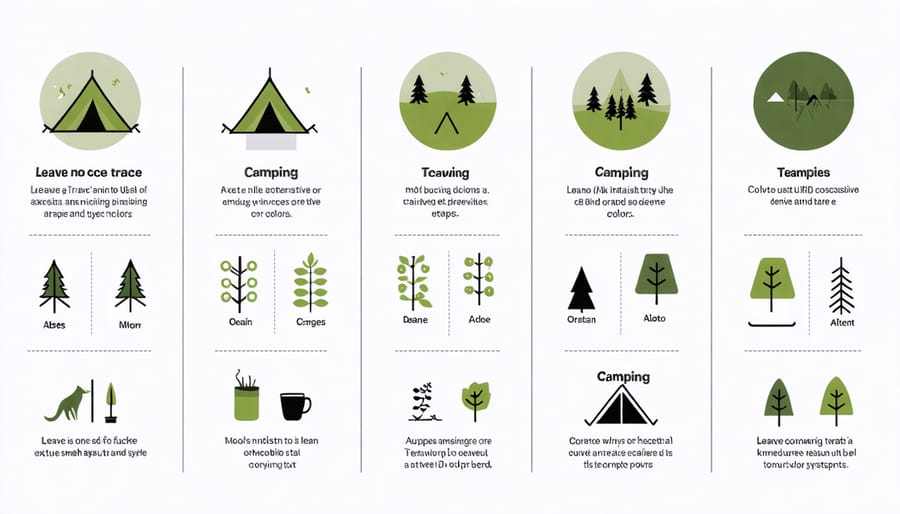
Leave-No-Trace Camping in Ontario Parks
Waste Management Guidelines
Remember the golden rule of camping: “Pack it in, pack it out!” Proper waste management is crucial for preserving Ontario’s beautiful wilderness and ensuring a pleasant experience for fellow campers. Always bring sturdy garbage bags and separate your waste into three categories: recyclables, compostable materials, and general trash.
Keep a dedicated food waste bag and store it with your food supplies in your vehicle or bear-proof container to avoid attracting wildlife. For recyclables, flatten containers to save space and rinse them to prevent odors. Many Ontario Parks have designated recycling stations – use them!
Pro tip: Bring a small spray bottle with water to clean dishes away from water sources. Strain your dishwater through a fine-mesh strainer to catch food particles, placing them in your waste bag. Dispose of greywater at least 50 meters from any water source.
Never burn your garbage in the campfire – it’s harmful to the environment and against park regulations. Before departing, do a thorough sweep of your site, checking under bushes and around the fire pit for small items like bottle caps or food wrappers. Leave your campsite cleaner than you found it – future campers and wildlife will thank you!
Minimizing Your Environmental Impact
Every camper plays a crucial role in preserving Ontario’s natural beauty for future generations. Start by selecting eco-friendly camping gear that minimizes your environmental footprint. When setting up camp, stick to designated areas and avoid trampling vegetation around your site.
Keep wildlife wild by storing food in airtight containers and never feeding animals, no matter how cute they might look! Use biodegradable soap for washing dishes, and always do so at least 30 meters away from any water source. This helps protect our lakes and streams from harmful chemicals.
Pack out what you pack in – this includes everything from food wrappers to apple cores. While fruit peels might seem harmless, they can take months to decompose and attract wildlife to campsites. Use designated fire pits only, and source your firewood locally to prevent the spread of invasive species.
Before leaving your site, scan the area thoroughly for micro-trash (like bread ties or bottle caps) and ensure your fire is completely extinguished. Remember, the best campsites are those that look untouched when you depart – as if you were never there at all!
Wildlife Safety and Food Storage
Bear-Safe Practices
In Ontario Parks, proper food storage isn’t just a suggestion – it’s essential for both your safety and the well-being of our local wildlife. Always store your food in your vehicle or a designated bear-proof container, never in your tent. If you’re backcountry camping, hang your food pack at least 4 meters high and 2 meters away from the tree trunk.
Keep your campsite scent-free by cleaning up immediately after meals and storing all scented items (including toothpaste and soap) with your food. A clean campsite is your best defense against unwanted bear visits. Even empty food wrappers can attract curious bears, so pack them away securely.
If you encounter a bear, stay calm and make yourself appear large. Slowly back away while speaking in a firm, calm voice. Never run or play dead unless in rare cases of physical contact. Most bears will avoid human interaction if given the chance.
Remember to check the park’s bulletin boards for recent bear activity and follow any additional guidelines provided by park staff. By following these practices, you’re not just protecting yourself – you’re helping maintain the natural behavior of our wildlife.
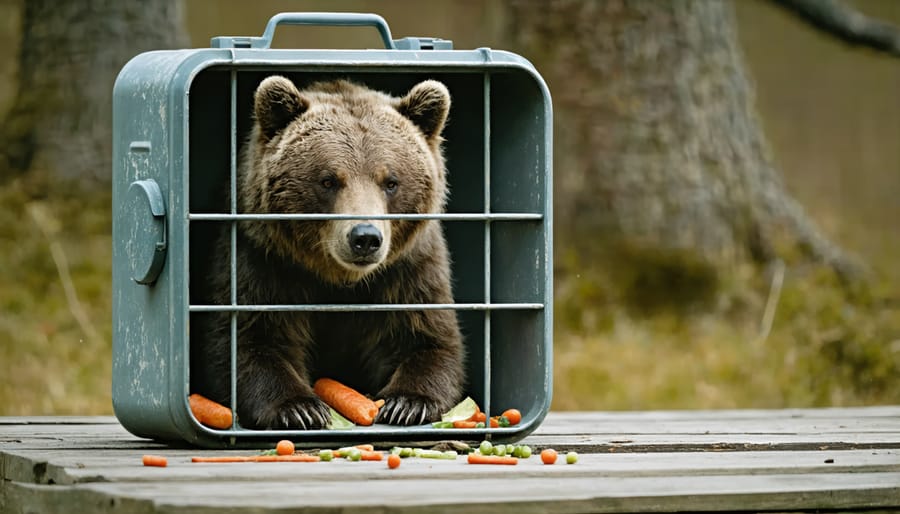
Small Animal Management
Ontario’s wildlife can add charm to your camping experience, but it’s essential to manage these encounters safely. Raccoons, squirrels, and chipmunks are common campsite visitors, especially in popular parks like Algonquin and Bon Echo. While these creatures may look cute, feeding them can lead to problematic behavior and isn’t permitted in Ontario Parks.
Store all food and scented items (including toiletries) in your vehicle or a sealed container when not in use. Never keep food in your tent, as animals can smell it and may damage your gear trying to reach it. Clean up immediately after meals and dispose of garbage in the designated wildlife-proof bins.
Pro tip: Hang dish towels and wet clothing inside your vehicle or tent at night. Raccoons are particularly attracted to these items and have been known to make off with campers’ tea towels!
If you encounter small animals, maintain a safe distance and avoid sudden movements. Remember, these are wild animals – keeping them wild by preventing access to human food helps protect both them and future campers. Consider bringing a small spray bottle with water to deter particularly persistent visitors without causing them harm.
Ontario Parks’ Rules and Etiquette
When camping in Ontario Parks, following proper Ontario Parks camping rules isn’t just about avoiding fines – it’s about creating an enjoyable experience for everyone while protecting our natural spaces.
Always check in at the park office before setting up camp, and keep your permit visible at your campsite. Quiet hours are strictly enforced from 10 PM to 7 AM, so keep those ghost stories and campfire songs within reasonable hours! Speaking of campfires, they’re only allowed in designated fire pits, and remember to purchase firewood locally to prevent the spread of invasive species.
Your furry friends are welcome but must be leashed at all times and never left unattended. Keep your site clean and store food properly – nobody wants unexpected wildlife visitors! Most parks have a maximum of six people per site, and your vehicles must be parked within your designated parking space.
Here’s a friendly tip from a seasoned camper: bring a collapsible garbage bin and pack out what you pack in. While most parks provide garbage facilities, it’s our responsibility to keep sites pristine. If you’re planning to collect firewood, remember that only dead and fallen wood is permitted – no cutting or damaging living trees.
Be mindful of your neighbors and respect site boundaries. Keep music at a reasonable volume, and if you’re using generators, stick to the permitted hours (typically 9 AM to 9 PM). Finally, leave your site as you found it – or better! This includes thoroughly extinguishing your campfire and ensuring no trace of your stay remains.
Proper campsite management is the cornerstone of an unforgettable outdoor experience in Ontario’s beautiful parks. By following the principles we’ve discussed – from thoughtful site selection and efficient setup to Leave No Trace practices – you’re not just creating a comfortable temporary home, but also preserving these natural spaces for future generations to enjoy.
Remember that successful camping is all about balance. While you want to make your site comfortable and functional, it’s equally important to minimize your impact on the surrounding environment. Simple actions like using designated fire pits, properly storing food, and packing out all waste make a significant difference in maintaining the park’s ecological integrity.
Safety should always remain your top priority. Keep your campsite clean, store food properly to avoid wildlife encounters, and always follow fire safety guidelines. Stay weather-aware and maintain your gear in good condition to ensure a safe and enjoyable experience.
As you head out to explore Ontario’s magnificent parks, take pride in being a responsible camper. Share these practices with fellow campers, especially newcomers to the outdoor community. Our parks are a precious resource, and through mindful campsite management, we can ensure they continue to provide incredible outdoor experiences for years to come.
Happy camping, and remember – the best campsites are the ones that look like they’ve never been used when you leave them!


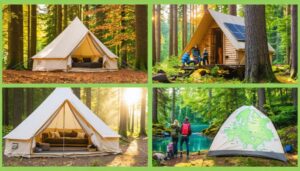





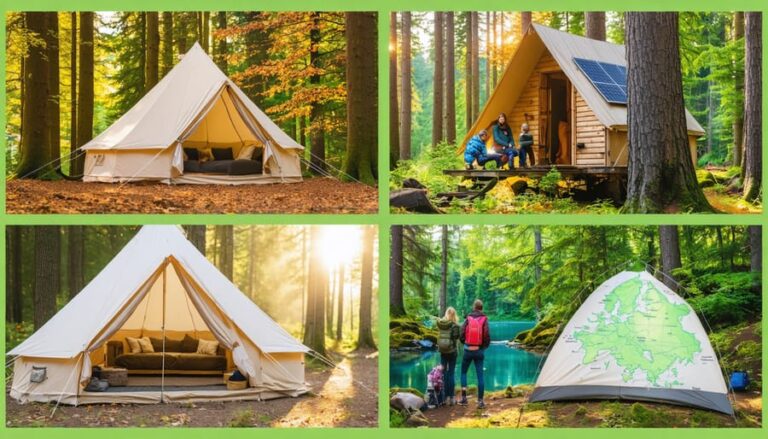

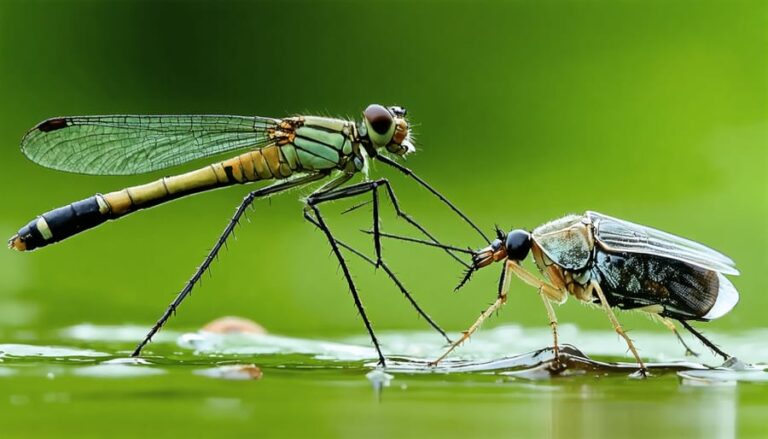


+ There are no comments
Add yours